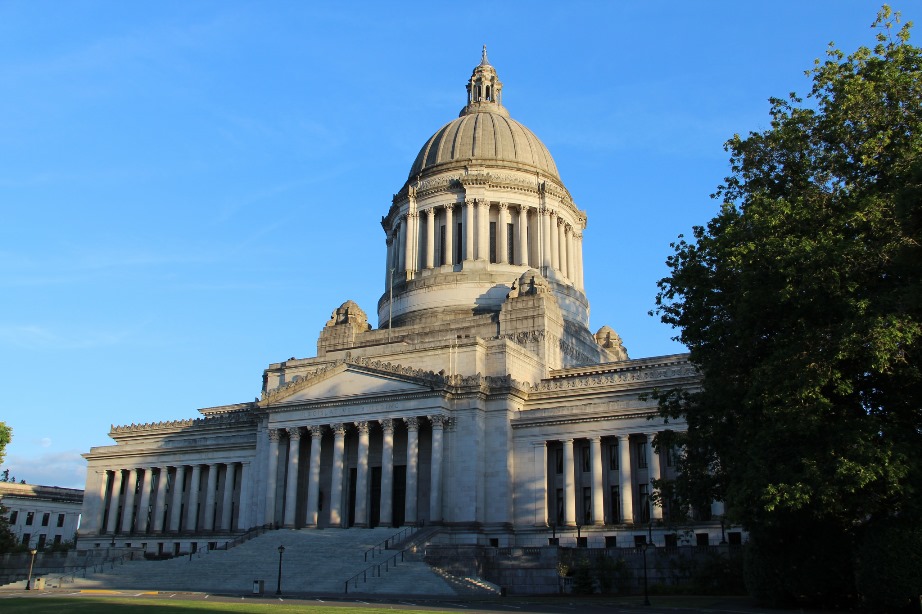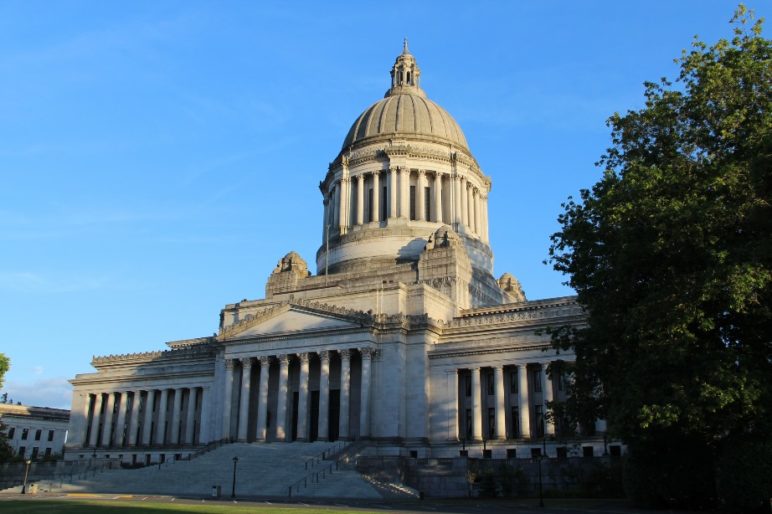The gas industry has big designs on the Northwest.
In Washington alone, its agents are busy in practically every corner of the state: backing a pipeline expansion in north Seattle, a controversial LNG facility in Tacoma, an ammonia fertilizer production site in Longview, a giant petrochemical export project on the Columbia River, and amping up gas-fired electricity production everywhere.
Meanwhile, the industry is also playing defense: trying to burnish its reputation after a catastrophic in-city explosion; hunting for new tax breaks to protect itself from renewable energy; staving off local attempts to take public control of utilities; and obstructing efforts to price and reduce climate pollution.
No industry establishes a reach like that without spending money—a lot of it. During the last decade, fracked gas interests poured nearly $14 million into Evergreen State politics, using every avenue available to gain clout. And the breadth of that clout surely hinders the region’s progress toward a clean energy future because so many key policymakers and institutions along the entire political spectrum benefit financially from the industry’s largesse. Companies made more than $2.2 million in direct contributions to candidates for office and gave nearly $3 million to political action committees, or PACs. But those sums almost seem paltry compared to the $8.5 million that gas corporations spent on lobbying in Olympia. The industry seems unconcerned with ideology, even as the breadth of its political spending indicates that it is deeply concerned with preserving a thorough influence.
The whole industry spends money on politics, but no one does it quite like Puget Sound Energy. In fact, PSE spent over $7 million in the last ten years, more than half of all spending by gas interests in Washington. (By contrast, many of the giant multinational corporations headquartered in Washington that dwarf PSE spent far less on political activities in Washington: Microsoft spent around $5 million, Amazon about $2 million, and Starbucks less than $310,000.)

Original Sightline Institute graphic, available under our free use policy.
We analyzed the political spending of the major players in Washington’s gas industry. Our accounting tabulates spending from the pipeline companies, investor-owned gas utilities, and owners of gas-burning power plants. Many of these companies have sprawling footprints over large swaths of North America, so we focused our analysis on lobbying in state government and on contributions to Washington candidates and PACs.
Fracked gas money flows to penny-ante local races, big dollar Congressional contests, progressive governors and their Republican challengers. It hedges its bets by funding right-wing electoral groups and the Democratic Party alike. It doesn’t seem to mind spending on losers, but you can be sure that in Washington gas money is backing the political winners.
Candidates for office
Since 2008, PSE has contributed $665,598 to a wide array of candidates in Washington. The firm pours money into the coffers of politicians across the ideological spectrum and up and down the ballot. It funds candidates for port commissioner, public lands commissioner, state legislature, city and county councils from Walla Walla to Fife.
The utility gives money to some of the staunchest climate champions in the state, elected officials with genuinely progressive track records like Beth Doglio of Olympia and Reuven Carlyle and Rebecca Saldaña of Seattle. It also funds races for the most conservative wing of the state’s Republican party, including Trump surrogate Doug Ericksen of Whatcom County, Curtis King of Yakima, and Pam Roach of south King County. It even finances both opponents in the same race sometimes. In a contentious 2017 special election for a state senate seat in the suburban 45th district, for example, PSE gave $2,000 to Republican Jinyoung Englund and $1,000 to Democrat Manka Dhingra.
PSE plays moneyball at the US federal level, too. The company’s PAC spent $351,831 on Washington candidates for the US Senate and House, including big sums to Democrats Adam Smith from south Seattle suburbs, Rick Larsen from northwest Washington, and Republican Dave Reichert representing east King County and central Washington.
The rest of the gas industry kicked in $1 million to candidates at the state and local levels and another $212,500 to Washington’s congressional delegation, including $71,600 to Republican Representative Cathy McMorris Rodgers of Eastern Washington and $22,500 to Democratic Senator Patty Murray over the most recent decade for which data are available.

Original Sightline Institute graphic, available under our free use policy.
PACs to stop public power
Unconstrained by campaign finance limits, PSE has funneled huge sums of money to political action committees (PACs) to the tune of $2,516,421. More than 60 percent of these contributions were routed to just four organizations—groups formed in opposition to local initiatives that would have given the public control of their electricity utilities.
After PSE was acquired in 2008 by an Australian investment firm, Macquarie Group, three Washington communities tried to wrest control of electricity distribution away from PSE, concerned that rates would rise and service would suffer. Jefferson County, Whidbey Island, and Skagit County voters were faced with deciding if they wanted to join the 28 percent of Washingtonians who get their electricity from public utility districts (PUDs).
In a classic astroturf strategy, PSE was the exclusive funder of shrewd political campaigns, Whidbey Consumers for Affordable Energy , Jefferson County Citizens Against Prop 1, and Skagit Committee for Reliable and Affordable Energy. The firm enlisted the services of consulting firm Strategies 360, a company that has repeatedly worked for Washington’s biggest polluters, and spread misinformation about the cost and risks of public utilities. Its scare tactics worked in Skagit County and Whidbey Island, but Jefferson County voted in favor of public power.
The issue flared up again in 2012 when Thurston County’s public utility district proposed to consider public distribution of electricity. The Alliance to Protect Thurston Power, a group primarily funded by PSE, outspent public power advocates by nearly $620,000 in the most expensive campaign in Thurston County history. Gas utility Avista also pitched in $5,000 to support PSE’s efforts. The measure failed by 11 points and PSE retained control of electricity distribution in Thurston County.
Partisan politics
PSE complements its targeted ballot campaigns with contributions to long-established partisan groups. In the last ten years, PSE has given $130,000 to Enterprise Washington and $65,000 apiece to the Leadership Council and the Reagan Fund, all groups that work to elect conservative candidates. On the other side of the aisle, PSE kicked in $65,000 to the Truman Fund, $35,750 to the Democratic Central Committee, and $35,000 to the Kennedy Fund, all organizations that channel money to Democratic candidates for the state legislature. Many of these donations were routed through lobbyists, a technique that helps to shroud the flow of money.
The rest of the gas industry is far from matching PSE’s spending, but these companies have still managed to contribute $42,500 to the Leadership Council, $31,000 to Enterprise Washington, and $35,000 to a campaign to defeat a 2016 carbon tax ballot initiative.
Lobbying
Meanwhile, these staggering sums of campaign cash are dwarfed by PSE’s spending on lobbyists. Since 2008, the corporation has spent more than $3.6 million on lobbying in Olympia, cycling through firms like Strategies 360, Alliances Northwest, and Millenia Public Affairs. Spending at these levels affords PSE a great deal of access and helps it in key political battles, such as winning a 2014 tax break for gas. The utility has also spent almost $11 million on lobbyists at the US federal level since 2008.
The politics of fracked gas
The numbers make clear that Washington’s fracked gas industry is fundamentally apolitical. Big players like PSE are not driven by ideological commitments, but rather by maintaining and extending a web of influence across all levels of government.
It’s a web that undoubtedly makes progress to a clean energy future more challenging because a climate-responsible future means forestalling the many gas industry proposals now on the table, just as it means vastly reducing existing gas infrastructure. But to do that, advocates and elected leaders alike will need to buck the interest of one of the Northwest’s most influential political players.
Paelina DeStephano aids organizations in their research needs, focusing her efforts on environmental policy and Puget Sound restoration. She’s a Seattle local with a background in international development and global health.
Notes and methods: Thanks to John Abbotts who contributed research to this article. We focused our analysis on the biggest gas companies in Washington: pipeline operators TransCanada and Williams, investor-owned utilities Avista, Cascade Natural Gas, Northwest Natural Gas and Puget Sound Energy; and PacifiCorp, which burns natural gas to produce electricity. (Northwest Natural Gas is the sole funder of the Natural Gas PAC and routes a significant share of its contributions through that organization, so for simplicity we report aggregate spending attributed to Northwest Natural.) The figures we report here are derived from records kept by Washington’s Public Disclosure Commission, the Federal Election Commission, and the Senate Office of Public Records. In reporting totals spent on Washington state-level lobbying we summed lobbyist compensation and miscellaneous expenses, but did not add in totals for contributions routed through lobbyists because those sums are usually captured in contribution data. Our method ensures that we do not double count these contributions, but it may mean some that some figures we report are a slight undercount.












Steve Ericksn
Sightline, how about some research to follow up on the 2008 PUD campaigns? PSE stated at the time that it would try to get its electric rates increased by ~10% per year to pay for the sale to MacQuarrie and the captured state Utilities and Transportation Commission has pretty much given them that. But what has happened in Jefferson County, where the PUD campaign won? A comparison of the change in electric rates between Jefferson County and the areas that rejected PUDs would be very interesting.
Steven Storms
PSE is a privately owned utility company. It should be a public utility company. They should not be allowed to meddle in politics. Being owned by a foreign country only makes it worse. Their political contributions are self-serving to their stockholders not the public ratepayers or even our country.
Phil B.
This doesn’t even begin to tell the story of the massive legal and greenwashing operations PSE maintains to get their way in all things, while managing public opinion.
jane lindley
Even at the local level they are completely enmeshed – we saw it first hand on Bainbridge Island when a small group of volunteers brought up the idea of a public utility. PSE reps were at every city council, comprehensive plan, utility advisory, planning meeting at city hall. They are on the board of the Chamber, give huge sums of money to the city, downtown association, local businesses – the money is great for Bainbridge but not so great for democracy. http://lowcarbongirl.com/island-power-effort-tabled-for-now/
Andrew Saturn
Don’t forget Linda Oosterman, who benefitted in her 2012 election bid from $8,993 spent by Puget Sound Energy on mailers. Her opponent was pro-Public Power, and in that same year, PSE spent over $660,000 fighting the Public Power campaign in Thurston County. In all, they spent millions on lobbying and attack ads, sinking public power and electing a corporate stooge to the Public Utility District, who has opposed public power and anything else for the past six years.
David P.
They’re still at it:
https://www.thestranger.com/slog/2019/07/23/40762694/why-is-seattles-natural-gas-utility-trying-to-flip-the-seattle-city-council